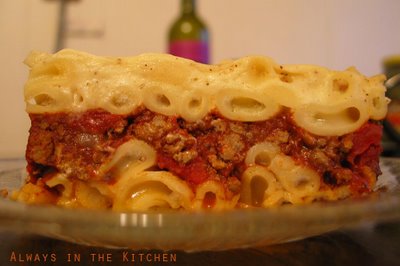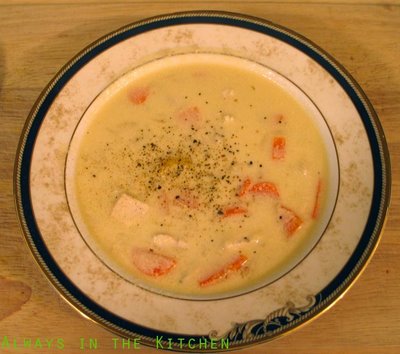My neighbourhood is quite well known for its Greek community - restaurants, banks, poolhalls, specialty import stores - often these are Greek-owned-and-run. I have my favourites, of course, whether it's a place to hang out or a place I might go for one specific dish.
I keep kalamata olives on hand, most of the time. I'm very fond of feta cheese. I never want to run out of oregano. I really dig lamb. I'm growing surpisingly fond of spinach, even. It shouldn't be a surprise to me, then, that I occasionally suffer from a sudden surge of Greek cooking.
I am not Greek. Not even a little bit, and lord knows, I'm a little bit of a lot of things. I do, however, often get mistaken for Greek or (insert other Mediterranean culture). It's the dark hair and vigorously growing eyebrows, I think; an illusion. However, if you were to walk past my house and smell the unmistakable aroma of lamb simmering with tomatoes, onions, cinnamon and allspice as I layer my way, brow furrowed, through making a
Pastitsio, you'd be excused for the mistake.

The wonderfully complex-tasting seasoning of
Pastitsio is a delicious hallmark of Greek cookery: the bold use of a number of spices that are often thought of as more
sweet flavours, for baking, are mixed into a familiar blend of red meat and tomatoes to make a highly aromatic (yet not "spicy") flavour, completely unlike either an Italian pasta dish or an Indian curry.
This marks my first attempt at Avgolemono, a soup I have long enjoyed at restaurants, but never bothered to make. At its heart, it is really a Greek variation on good ol' chicken noodle soup. Chicken broth, a few minimal vegetables, and some orzo pasta. Where it departs from the standard is the generous addition of lemon juice and, in my case, lemon zest, too, and the use of egg. Avgolemono is a dairy-free soup, its subtle and creamy texture coming from beaten egg that is stirred carefully into the soup to create a texture more like crushed velvet than the rags of an Italian
Stracciatella. After examining a number of recipes, I decided to go it alone based on the common principles of all the recipes I had seen, plus all the avgolemonos I've eaten.
It was shockingly easy. It was very tasty. And, the next day, for lunch, it was even better (and a teensy bit thicker).
 Avgolemono
AvgolemonoServes 4
2 teaspoons rendered chicken fat or canola oil
4 cups strong chicken stock
1/2 small onion, finely chopped
2 cloves of garlic, minced
1 large carrot, peeled and cut into quarter-slices
1/2 teaspoon oregano leaves
1 bayleaf
1/2 cup orzo
juice of one lemon
3 wide strips of lemon zest
salt & pepper to taste
1 egg, beaten
1 cooked chicken breast, diced
Melt the chicken fat in a medium soup-pot. Add the onion, garlic and carrot, and cook and stir until the onion becomes a little translucent. Add the oregano and bayleaf, and stir. Add the chicken stock and orzo and simmer, stirring, for about 6 minutes, or until the orzo begins to get tender. Add the cooked chicken breast and reduce the heat slightly.
Remove about a cup of hot broth (avoiding any chunks) from the soup pot and add it slowly to the beaten egg in a small bowl, beating well (an immersion blender is great for this). Add the lemon juice and zest to the soup, lower the flame under the soup to very low, and add the beaten egg/broth mixture. Cook and stir over the low flame until mixture thickens, but do not let it boil, or you will have a raggedy look to the soup's texture. Taste and adjust for salt.
 How right she was, to be so enthused! I paired this tasty offering with lemon-orzo (still suffering from a little Greekitis, I guess), broccoli, and cumin-roasted yam cubes. I realized after I had taken the picture, that I hadn't yet sprinkled the lemon zest over, which was very pretty but by which point we were all starving - precluding the time for more photography.
How right she was, to be so enthused! I paired this tasty offering with lemon-orzo (still suffering from a little Greekitis, I guess), broccoli, and cumin-roasted yam cubes. I realized after I had taken the picture, that I hadn't yet sprinkled the lemon zest over, which was very pretty but by which point we were all starving - precluding the time for more photography.

















